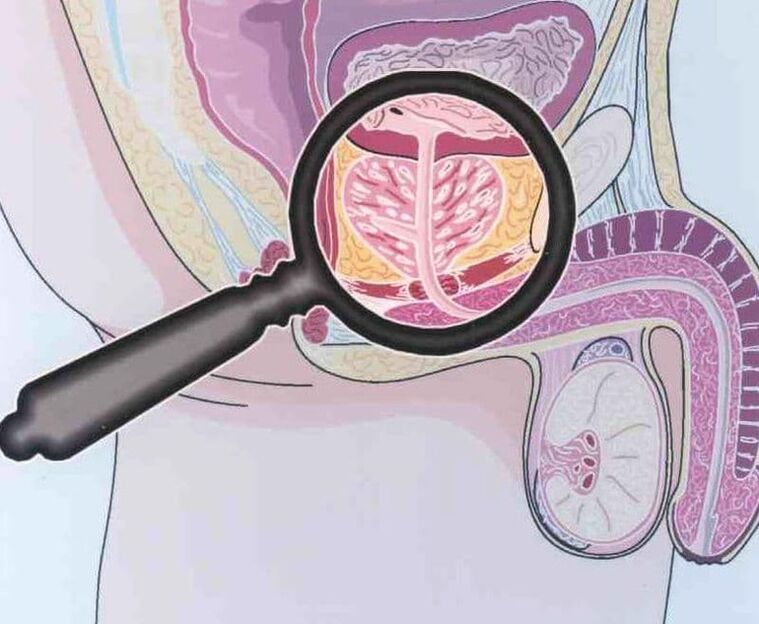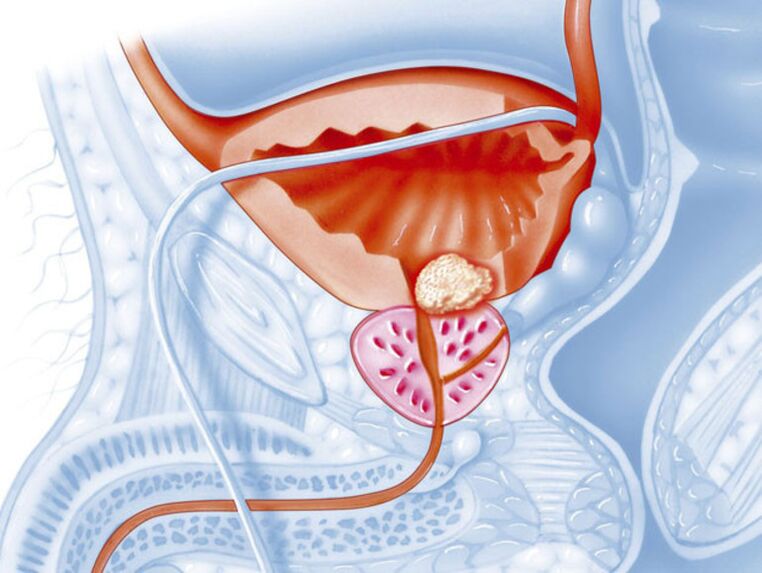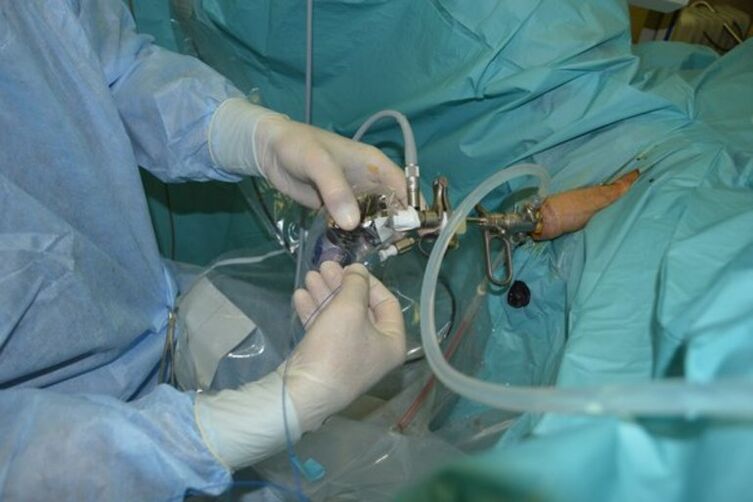Middle-aged and elderly men often suffer from pathologies of the genitourinary system related to the prostate gland. This organ is prone to inflammatory processes that cause serious discomfort. The most common pathology is chronic prostatitis. It is difficult to treat and is accompanied by severe clinical manifestations.

Causes of pathology
According to statistics, about 30% of men of reproductive age suffer from one or another form of prostatitis. In almost 70% of cases, the disease is asymptomatic, which is dangerous for health.There are many reasons for the development of pathology:

- Ignoring the symptoms of the acute form of the disease often leads to its transition to the chronic stage with periodic relapses.
- Regular hypothermia of the body and frequent catarrhal pathologies cause inflammation of the gland.
- Sedentary lifestyle causes stagnation of blood in the pelvis and leads to impaired blood supply to the prostate gland. If a man's professional activity is related to a constant sitting position, the probability of developing prostatitis increases several times.
- Choosing tight underwear that squeezes the genitals.
- Bad habits (alcohol abuse, smoking) often lead to the development of pathology, because they contribute to the disruption of all vital processes in the body.
- Chronic infectious diseases of the urinary system can also cause inflammation of the gland.
- Venereal pathologies of acute and chronic forms. If the recommendations of a specialist are violated or the symptoms of the disease are ignored, the infection can spread to the gland.
- Frequent stress and nervous exhaustion. Such factors can cause pathology, especially with a simultaneous decrease in immunity.
- Lack of minerals and vitamins in the daily diet can be a predisposing factor. If the deficiency is permanent, chronic prostatitis is accompanied by other diseases.
Infrequent sexual intercourse and the absence of a permanent partner increase the risk of developing chronic prostatitis. In this case, the treatment is also delayed, because the patient experiences not only physical but also emotional discomfort.
Disease classification

Depending on the cause of the beginning and progression of the pathological process, two types of the disease are distinguished: bacterial and non-bacterial. Separately, experts distinguish asymptomatic or atonic prostatitis. Each type has its own characteristics.
Bacterial prostatitis is easily detected during diagnostic examination. Tests usually indicate the source of the inflammation. There are especially many pathogens in the secretion secreted during gland massage. The level of leukocytes in the blood is almost always elevated because the body produces them in large quantities to fight pathogens.
The non-bacterial form of the pathology is characterized by a milder course, but almost always the patient suffers from severe pain in the small pelvis. Pelvic pain syndrome is considered the main criterion for diagnosis.
It is very difficult to determine the asymptomatic type of the disease, because there are no obvious signs of inflammation. Pathological changes occur in the prostate, but the man does not feel it. A specialist diagnoses by accident or during an examination for other pathologies.
Clinical picture
In the acute form of the pathology, a man immediately feels the deterioration of his condition, but in the case of chronic prostatitis, there may be no symptoms, which makes the diagnosis very difficult.As the disease continues for a long time, the following symptoms appear:

- discomfort during urination, extending to the projection area of the bladder;
- frequent urge to urinate with a simultaneous decrease in the amount of urine excreted;
- anxiety during sexual intercourse, problems with erection and ejaculation;
- a feeling of incomplete emptying of the bladder associated with the narrowing of the duct, which leads to long but unproductive urination;
- the development of cystitis, pyelonephritis associated with the multiplication of bacteria in the bladder and the spread of the infection to the kidneys;
- change in urine color, the appearance of blood or pus impurities;
- decreased libido;
- general weakness, fatigue, decreased performance;
- irritation and psycho-emotional stress;
- slight increase in body temperature;
- pain in the pelvis and scrotum, radiating to the sacrum or rectum.
The severity of symptoms depends on the degree of damage to the tissues of the prostate gland. Sometimes the patient has only pain and no other symptoms.
If the patient does not consult a doctor for a long time, complications may arise. The most common of these is vesiculitis or inflammation of the seminal vesicles. Often, when the symptoms of chronic prostatitis appear at a young age, patients are diagnosed with infertility, which is difficult to treat.
The most dangerous consequence of untreated or neglected prostatitis is prostate cancer. Often, a benign pathology of the organ develops - an adenoma, which can turn into a malignant tumor.
Diagnostic methods
Before treating chronic prostatitis, it is necessary to undergo a comprehensive diagnostic examination. During the initial treatment, the specialist conducts an interview with the patient, learns about his habits, lifestyle characteristics, frequency of sexual intercourse and professional activity. The information helps to identify the suspected cause of the disease. Then the doctor listens to the patient's complaints and determines the degree of damage to the gland.

The next stage of diagnosis is clinical blood and urine tests. They are usually manifested by an increase in the number of leukocytes and an increase in the sedimentation rate of erythrocytes. This indicates the presence of an inflammatory process in a man.
The patient should undergo an X-ray examinationultrasound examination of the prostate gland. Thanks to these methods, you can see changes in the structure of the body, deviations in one direction or another. In addition, computed tomography can be performed to identify accompanying pathologies of the genitourinary system.
If a tumor is suspected, a biopsy sample should be taken. In the laboratory, specialists study the structure of the cell and make a final diagnosis. If the tumor is benign, doctors additionally determine the probability that it will turn into a malignant tumor. After receiving the results of the diagnostic examination, the specialist determines the direction of the therapy.
Medical therapy
Treatment of chronic prostatitis with drugs is considered the most common method. If there is a possibility of treatment, doctors always choose a conservative method.The most commonly used drugs are:
- Antibacterial substances can relieve inflammation in a short time and prevent the process from spreading to neighboring organs. Most often, tablet forms of penicillins and fluoroquinolones are used. When the mold is working, a powder is prescribed to prepare the solution. The drug is administered intravenously or intramuscularly in a hospital setting. With the ineffectiveness of these drugs, more powerful macrolides are used. Popular drugs in this group are available in the form of tablets and lyophilisates for the preparation of an injection solution. The course of treatment lasts between 10 and 20 days, depending on the severity of the condition.
- Non-steroidal anti-inflammatory drugs are prescribed to relieve pain and prevent further development of the pathological process. The course usually does not exceed 7 days. Patients with pathologies of the digestive system should not take such drugs without consulting a doctor first.
- Muscle relaxants help relax smooth muscles and facilitate urination. The duration and dosage of therapy is determined by the doctor.
- Rectal suppositories eliminate swelling, pain and inflammation, improve the general condition of the patient. The duration of the therapeutic effect is 10-14 days.
Also, the therapy regimen includes vitamin complexes to strengthen the immune system and quickly restore the body after treatment. Among such funds there is a complex specially designed for men. The minimum duration of its admission course is 30 days.
Surgical intervention

If the pathology cannot be treated conservatively, the doctor decides to perform an operation to completely or partially remove the organ. An absolute indication for surgical intervention is prostate cancer.
The method of transurethral resection consists of splitting the urethra and removing part of the gland to relieve the condition. If removal is not required, a simple dissection of the organ is performed to normalize urine output.
The open adenomectomy method is used with a significant enlargement of the gland and the addition of other pathologies. The operation is performed under general anesthesia. The technique is more commonly used to treat older patients when other tools and interventions are ineffective.
Use of physiotherapy

In parallel with drug treatment, physiotherapy is often used to speed up recovery and prevent complications.The most popular and effective method is massage.prostate through the rectum. The technique improves the blood supply and nutrition of the organ, prevents the spread of inflammation to neighboring organs.
At least 10 sessions are necessary to achieve a therapeutic effect. The procedure is performed by a specialist in a hospital or clinic.
Electrophoresis in the projection area of the prostate allows it to normalize blood flow. The essence of the technique is the use of low-frequency electric current, which has a positive effect on the condition of the genitourinary system, stimulates tissue regeneration and removes inflammation. The course is at least 10 sessions, sometimes more procedures are required to achieve permanent results.
Ultrasound and laser therapy, paraffin therapy and other methods are often prescribed. The choice of treatment method depends on the individual characteristics of the patient's body.
Preventive measures
Following simple rules will help prevent the development of chronic prostatitis. It is recommended to avoid hypothermia and lead an active lifestyle. You should not torture the body with vigorous exercise, but moderate and regular exercise will help prevent blood stagnation in the pelvis and the development of prostatitis.
Experts recommend including pumpkin seeds, fresh vegetables, fruits and greens in your diet. Do not abuse alcoholic beverages. Stopping smoking will reduce the risk of developing the inflammatory process. A balanced diet will help protect the immune system, prevent colds and viral pathologies.
To prevent prostatitis, it is necessary to consult a urologist every 6 months. This will detect the pathology at an early stage and prevent it from turning into an indifferent form. When the first signs of the disease appear, you should visit a medical institution to start therapy on time and prevent complications.





























